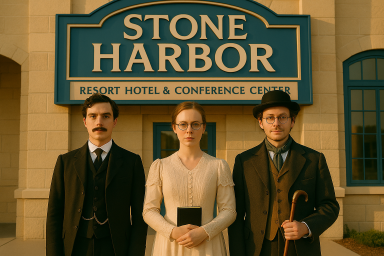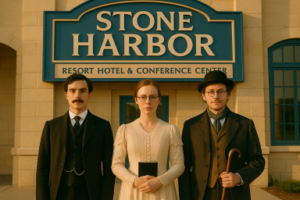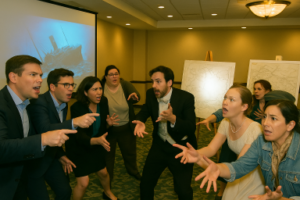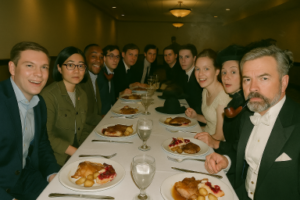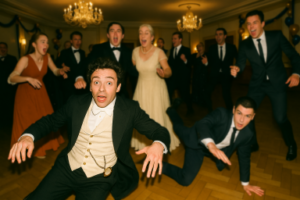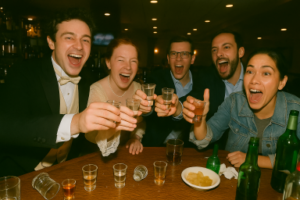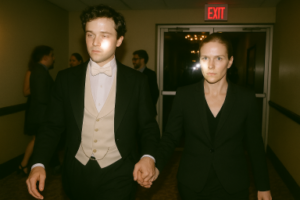Dr. Basil Cartwright, Visiting Concordant and Lecturer in Littoral Archaeologies
Journal Entry
Sturgeon Bay, Great Lakes Shipwreck Congress & Ball
The day began not with scholarship but with song. Our delegation gathered at Rawley Point in the waning afternoon, carpooling northward in two overburdened wagons of dubious comfort. Eleanor Price, irrepressible, led the company in sea shanties the entire drive, while Whitcomb attempted counter-harmonies that strained both voice and patience. We paused briefly at the tower of the Door County Maritime Museum, where the bay below shone copper in the declining light. It was a rare moment of quiet reverence—long shadows stretched across the water, the air still warm yet edged with autumn’s crisp intent.
The Congress was convened at the Stone Harbor Hotel and Conference Center, perched upon the canal, its ballroom aspiring to grandeur with chandeliers, nautical carpeting, and tall windows overlooking the marina.
The sessions themselves were a curious mixture of substance and spectacle. The GLRC opened with a keynote on AI-Enhanced Sonar Reconstructions of the Schooner Fleet, accompanied by a holographic rendering projected across the hall. The audience gasped, though I found the flickering polygons a poor substitute for Whitcomb’s hand-drawn bathymetry. Our Order countered with a paper by Eleanor Price, Seiche Events as Living Memory of the Lakes, delivered with such earnest enthusiasm that even the GLRC statisticians applauded politely.
Later, Dr. Fiona Markham of the Consortium unveiled her “Digital Archive of Wreck Debris,” a presentation heavy on animation but light on fieldwork. In rebuttal, Barlow presented a diver’s account of the Kate Kelly wreck, his description of zebra mussel crusts more vivid than any computer model. The hall murmured approvingly.
By late afternoon, the proceedings adjourned, and attention shifted from charts and papers to table linens and wine glasses. The banquet menu was arranged with contemporary flourish befitting the Congress. We began with consommé, clear and aromatic, followed by smoked whitefish laid upon greens with dill cream. The main dish was roast duck with cherry reduction, accompanied by new potatoes and late-summer roots. Dessert arrived as a pair: Door County cherry torte and a modest custard, flanked by demitasses of coffee strong enough to blister enamel.
It was amid this respectably modern fare that impropriety crept in. For even as we dined, the windows framed the last golden strata of sunset, and into this scene strode a tall man in a charcoal traveling coat. He delivered his twin briefcases with silent precision—one to Dr. Markham of the GLRC, one to Alistar Corvus at our table. His departure was as swift as his entrance, leaving unease like sediment stirred from the lakebed.
From that moment, all semblance of decorum seemed fated to erode. The dancing began with Strauss, dissolved into Gershwin, and then—without warning—the orchestra ceded the floor to some manner of disc jockey. The waltz gave way to what I am told is hip-hop. The open bar had already eroded restraint; from there, matters spiraled.
Gerald Whitcomb, against all counsel, entered a so-called “dance-off” with a GLRC post-doctoral fellow. Their contest was met with cheers from Eleanor Price, who spun in circles and declared it “a ritual echoing the Algoma powwows.” Whitcomb attempted a floor spin, succeeded only in ensnaring his compass chain, and was rescued by two waiters.
Mags Fielding, Treasurer, declared each round of spirits a “dues pre-payment,” ensuring the coffers are now either embarrassingly flush or catastrophically miscounted. Barlow, emboldened by excess champagne, joined Dr. Markham in movements I can only describe as frenetic calisthenics to the beat of an urban hymn. All the while the briefcases remained untouched, lit intermittently by disco strobes—a ludicrous beacon amid the collapse of dignity.
Toward the close of revelry, I saw Barlow and Dr. Markham slip hand-in-hand past the coatroom, bound for the shipyard lights of Fincantieri. At nearly the same moment, Whitcomb, red-faced but oddly serene, departed arm-in-arm with the GLRC cartographer.
Thus ended an evening of mixed flavors: consommé and cherry torte, sea shanties and hip-hop, romance and rivalry, scholarship and scandal. I confess myself unsettled, uncertain whether the Order’s spirit was strengthened or diluted in the exchange. Only time—and perhaps the contents of those cases—will tell.
—B.C.
